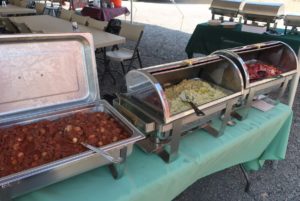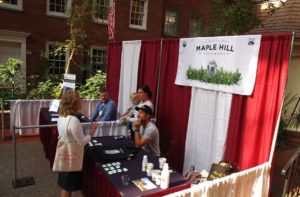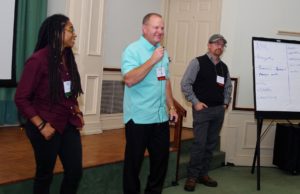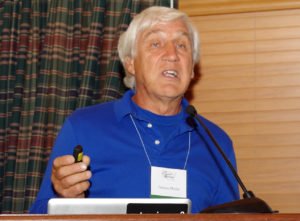




Corn is the dietary staple of most cattle because it’s an inexpensive feed that fattens the animals quickly – but that comes at the expense of the cow’s own health. Grassfed cows are healthier and the meat and milk that comes from them is better for humans. And the cycle of grass-based grazing is better for the land, water, and air.
Fortunately, grassfed meat is becoming a serious market force, a message that underscored this year’s annual conference for members of the Grassfed Exchange, a volunteer organization that has spent nearly a decade collecting and disseminating information to anyone involved or interested in the product. The sold-out conference, which took place September 27-29 at the Desmond Hotel in a suburb of Albany in upstate New York, brought together 500 attendees (100 more than last year’s conference) from 40 states as well as from Canada, Holland, Australia, Algiers, Auli (in the Chamoli district in India’s Himalayan mountains), Great Britain, and Norway. Previous conferences have taken place in Nebraska, North Dakota, Missouri, Michigan, and Georgia; this year, New York’s extensive amount of grassfed dairies and grassfed cattle was recognized.
The conference kicked off with tours of two such farms: Dharma Lea, in Sharon Springs (Schoharie County, NY), and Black Queen Angus Farm in Berlin (Rensselaer County, NY). Both are family-run businesses that take a holistic approach to grassfed cattle management, and Dharma Lea demonstrated the gustatory effectiveness of such a practice by offering a lunch prepared from their own beef, with some help from a neighboring farm, along with locally sourced organic potatoes, eggs, dairy products, and root vegetables.
Boots and dungarees were the norm for the farm tours, and the dress code didn’t change once the folks got back to the hotel. The ensuing two days of talks and trade show featured an impressive array of speakers addressing topics ranging from land cultivation to butchering to marketing.
From Grass to the Grocery Store Shelf was the theme of a talk by Francis Thicke, who owns and runs the 90-cow Radiance Dairy in Iowa (with the highest five cow rating from the Cornucopia Institute), and has been an organic farmer for over 30 years. He and his wife, Susan, take their product from barn to bottling and on into the select stores and restaurants that buy as much as he can produce.
He described himself as a “recovering bureaucrat,” noting that he worked as a National Program Leader for Soil Science at the USDA-Extension Service. He also has served as a member of the National Organic Standards Board. Away from bureaucratic demands, Thicke radiates a pleasant, laid-back nature. “We start by going all the way back to the soil,” he began, which isn’t surprising – he has a Ph.D. in Agronomy/Soil Fertility from the University of Illinois. “We’re talking about geologic material that has been affected by plant matter,” he said, and what followed was an elegant tour through ecological cycles that too often suffer from the monoculture of industrial agriculture.
“Midwestern agriculture is inherently leaky. Two-thirds of Iowa’s surface is planted in corn and soybeans,” he said. “The result is that water percolates down into the soil with too many nitrates.” It’s a problem that can be solved with cover crops. “You should have something growing on your land at all times.”
Other talks covered such topics as Regenerative Agriculture and Why Bugs Matter, Kale vs. Cow, The Keys to Ecosystem Health, The Multi-Species Advantage, and a talk titled Water Is a Verb by noted ecology writer Judith D. Schwartz (author of Cows Save The Planet and Water in Plain Sight).
At the talk Honoring Meat, Jeremy Stanton, who trained at the Culinary Institute of America at Hyde Park (Dutchess County, NY) and has helmed kitchens in New York, Florida, and the Berkshires, where he lives, noted that “The art of butchering is the art of marketing,” Stanton has butchered and sold meat in his own retail setting, and currently operates Fire-Roasted Catering in Great Barrington (Berkshire County, MA), creating events that feature an open wood fire for the cooking. “It’s about making the display case look beautiful.” Key to that is learning how to communicate with the slaughterhouse you work with.
“On your cut sheet, be as clear as you can about what you’re asking for. You have to decide what cuts will be the most valuable to you – do you want to sell tri-tip (the triangular muscle cut from the bottom sirloin) and flatiron steaks? – and how exclusive you want to be. I find that the Porterhouse doesn’t sell very well. I’d rather sell the individual strip loin and tenderloin cuts.” Stanton’s knowledge of cuts of meat was extraordinary: “Some of the cuts, like the merlot steak, from the side of the heel, are never worth the effort and time. You can spend 15 minutes butchering time to get that merlot cut.” But this fine point prompted a mildly dissenting response from attendee Larry Althiser, who runs Larry’s Custom Meats in Hartwick (Otsego County, NY). “If you’re not a difficult customer,” he said, “we’re happy to do special requests. If it’s a special cut, and we’ll be doing it again and again, the rhythm will come. Cutting the merlot steak is really just a few extra swipes of the knife, but there certainly are other cuts that can take longer.”
Asked his opinion of the future of artisan butchering, Stanton said, “It’s wildly inconvenient to most people. It means making a second or third stop when you’re shopping, and you might be buying something unfamiliar, which means you’re taking a risk, cooking something you weren’t planning on cooking and paying more for it.” Morgan Hartman, of Black Queen Angus Farm, agreed, noting that only two percent of the USA population is actively farming, “which means that 98 percent are disconnected from their food. So this is also about the re-education of the consumer. We need to catch them when they’re young with good food.” Said Stanton, “If you really want to appreciate the superior flavor of grassfed beef, have a tasting with friends. And throw a grocery-store steak in there for contrast.”
The talk, The Ins and Outs of Grass-Fed Beef featured three speakers with deep insight. Jasmine Dillon, a PhD candidate in the Department of Animal Science at Penn State University, has combined interests in grazing systems and food security into her dissertation research on multiple sustainability indicators for grassfed beef production systems across the country. She emphasized the need to examine the environmental footprint. For a beef operation, this includes resource inputs (fuel, fertilizer, machinery, the animals themselves) that go to animal and food production as well as manure handling, with resulting air, soil, and water emissions. And there are measurable components to that footprint that include carbon, reactive nitrogen, fossil energy, and water.
Dr. Jason Rowntree, chair of the Grassfed Exchange, is also the faculty coordinator for The Lake City Research Center at Michigan State University – the first academic farm (with its 810 acres of managed land and 180 beef cows) to become an accredited hub for Holistic Management working with the Savory Institute. “The way I made it work was to bring in people who know more than I. Together we formed a holistic goal, centering our research around grass-finishing and around human health.” Production and profitability is tied to genetics, forage management, animal handling, and post-carcass management, he explained. “Genetics are all about energy metabolism. Those cows have to eat a crap-ton of grass.” Most cows eat about 1.1 percent of body weight, he said, “but my cows eat 1.5 percent. Cover crops increase quality in the last 60 to 90 days of finishing. Using a complex mixture can give a 20 to 25 percent increase in carcass weight.”
And the third speaker, Dr. Allen Williams is a founding partner of Grass Fed Beef, LLC, and Grass Fed Insights, LLC, and is also a partner in Joyce Farms, Inc. (a family farm in Winston-Salem, NC, with partner farms located in the Carolinas, Georgia and Virginia, which process and market beef, poultry and game). Williams pioneered many of the early grassfed protocols and forage-finishing techniques, and describes himself as “recovering academic,” thanks to fifteen years on the faculty at Louisiana Tech University and Mississippi State University. He offered advice for transitioning from conventional to grassfed. “You have to start with soil health, increasing the microbial population. Then you need complexity and diversity in your pastures. The monoculture farming we’re used to makes it more difficult. Then there’s genetics. You have to look at the proper phenotype and bloodlines. Also, you should understand how being a finisher affects your bottom line. Know what finished cattle looks like – and have a market!
How can we nudge consumers to eat more grassfed meat? “Let them know the story around the product,” said Williams. “It’s coming from a local or regional family farm. There’s no feedlot. No antibiotics or hormones. And it’s a great, consistent product. For health benefits, just look at the fatty-acid profile. The omega-3 numbers are substantial, especially compared to an infrequent portion of salmon.”
The talk Grass Fed Dairy Excellence was led by Maple Hill Creamery’s Tim Joseph, who sources milk from over a hundred small family farms, at the center of which is the 250-acre dairy farm that Tim and Laura Joseph bought when they expanded their own farming operation in 2003. “I wanted to stop working in the corporate world,” said Tim, and because they realized that a crop income comes only once a year, they “got some cows” at the very start of their farming life. Joseph’s talk was given in conjunction with Phyllis Van Amburgh, co-owner of Dharma Lea, the first of the farms to sign up with Maple Hill Creamery as a milk supplier.
Van Amburgh looked at the challenges of the dairy farm itself. “The cows have high metabolic needs, which makes them fairly fragile. You need a cow that can thrive on high-energy, highly mineralized forages.” Like many others, she stressed the importance of genetics. “We do our own breeding, so we’re able to produce cows that we find to be the right size – smaller, usually. But we need cows that put on weight easily.” Her farm has a herd of 75 right now, but it’s been successful enough to prompt expansion plans that should more than double that number.“You have to learn to adapt. You can’t have a cow that’s too rugged or you’ll get no milk, so you always have to give a little bit.”
For the Josephs, becoming dairy farmers became a trial-and-error process, but eventually they not only learned how to cultivate cattle but also took their herd to grassfed, certified organic status in 2007. “At which point we were more broke than when we started.” Tim sought an alternative to milk sales, and hit on the idea of producing yogurt. Maple Hill Creamery’s success now sustains not only the Josephs’ own 250-acre dairy farm but also the small family farms (over a hundred) who provide the creamery with milk from grassfed cows.
Asked how to teach consumers about the merit of grassfed product, Joseph suggested using any tools available, such as in-person conversation, social media, promotional events – “You’re not going to convert the consumer who wants 36 grams of sugar in yogurt that tastes like Trix for kids.” But not knowing the story of our food according to Joseph is abnormal: “We need to tell consumers that story, and we only get a few square inches on a cup or a carton to tell it. Those little circles of information, called ‘bugs,’ tell you if it’s organic, kosher, grassfed, non-GMO, and so on. [Editor’s note (FWB): Last month we reported on misleading language used on yogurt containers to market yogurt that was no longer produced from pastured animals.] We only have a few seconds for the consumer to take all that in.” And Joseph maintains that there must be one voice about what grassfed means: “Does it mean no grain or corn, ever? Many consumers believe that, in which case 80 percent of the dairy-case items claiming to be grassfed don’t meet those standards. We need to come together for the greater good of grassfed and dairy.”
(B.A. Nilsson, 10/11/17)
[Editor’s Note (FWB)– David Montgomery’s appearance at the Grassfed Exchange conference in the Albany area was especially notable. Montgomery’s Dirt, The Erosion of Civilization, is a remarkable accomplishment: a history of world agriculture in one very readable volume. We regret not hearing him speak on his new book, Growing a Revolution: Bringing our Soil Back to Life at the conference. Also check out our farmstead yogurt directory and our pasture raised meat directory which spotlights Eatwild’s directory of more than 1400 pasture-based farms.]





